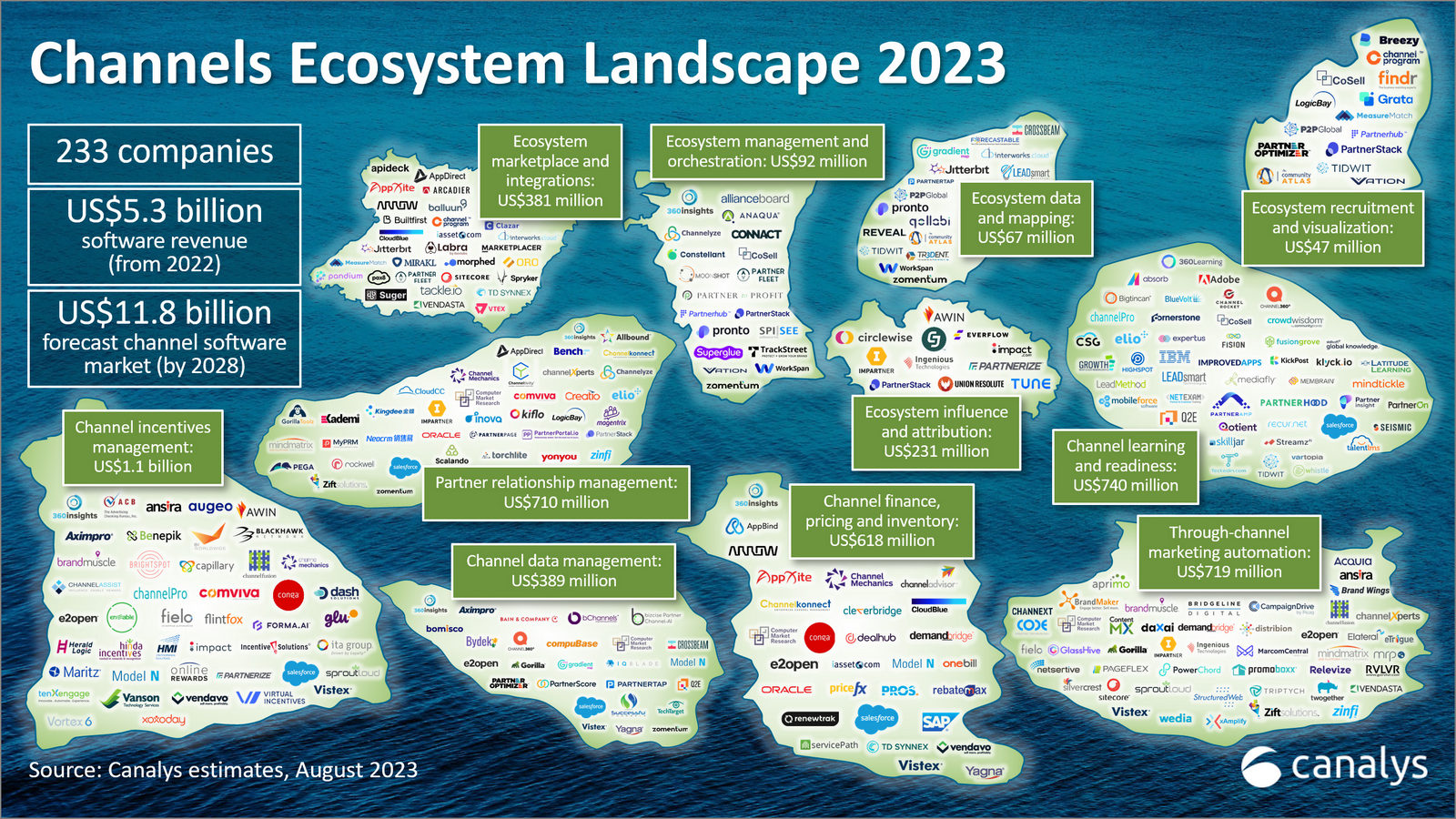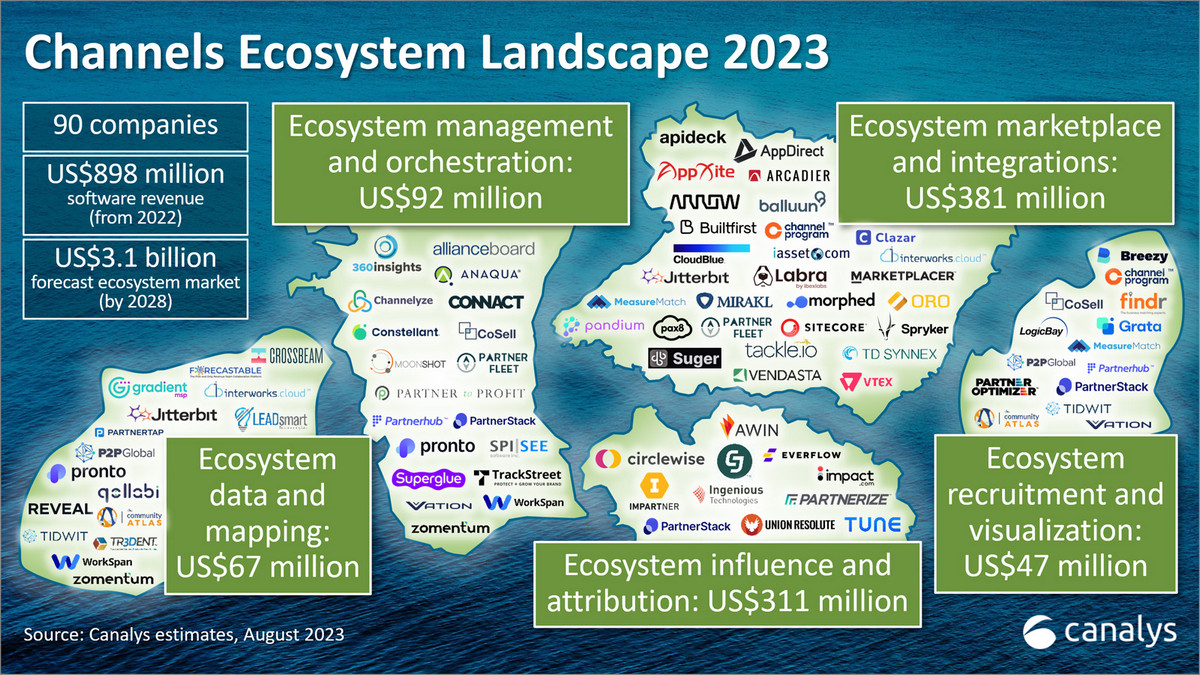What is the Canalys Channels Ecosystem Landscape?
We have developed this research to bring focus to the underlying technology that will drive competitive advantage in the decade of the ecosystem. The hundreds of software companies represented in the landscape are providing automation and advanced digital capabilities to help companies design, develop, execute and manage a broad partner and alliance ecosystem.
There are increasing demands on channel professionals to find, recruit, onboard, develop, incentivize, co-sell, co-market, co-innovate, measure, manage and report on partner value at scale. Automation, deeper integrations and data-driven decision-making are creating measurable competitive advantage (through partnerships) and are quickly becoming table stakes in the industry.
Canalys research shows that there are now 223 companies forming the ecosystem software landscape represented here. These companies represented US$3.9 billion in channel category revenue and raised over US$3 billion in private equity funding last year. The latest Canalys forecasts show that this channel software market will reach US$8.9 billion in revenue by 2027. This research currently excludes China, India, and parts of SE Asia as Canalys continues to examine the markets and to robustly apply our global research methodology.
Some interesting facts about this landscape:
- The average company is 17 years old. 17% of companies are less than five years old.
- Two thirds of companies hail from the US. The UK is next with 18 companies, then Canada with 13, then France and Germany with eight each.
- Top regions in the US are California with 53 companies, Massachusetts with 15, and New York and Texas, both with 11.
- 26,459 employees are focused on building, selling and marketing channel ecosystem software.
Canalys Channels Ecosystem Landscape 2022
The channels ecosystem ‘‘islands’’
Channel data management
Channel finance, pricing and inventory
Channel incentives management
Channel learning and readiness
Partner relationship management
Through-channel marketing automation
Channel Ecosystem Management
There are five 'islands' within this -
- Ecosystem recruitment and visualization - Assists in planning, identifying, targeting and recruiting non-traditional partners to drive the expansion of the channel ecosystem and the total addressable market. Provides actionable go-to-market and route-to-market expansion beyond current buyer, industry, geography, segment, delivery or product boundaries.
- Ecosystem influence and attribution - Supports marketing attribution in the post-cookie marketing environment, delivering recognition and incentivization of affiliates, advocates, ambassadors and influencer partners. Helps vendors’ data-driven platforms quantify partner influence and activities and their effect on marketing, sales and retention.
- Ecosystem data and mapping - Enables data-sharing opportunities with and between partners in a controlled and secure manner. Automates account mapping to leverage network effects and streamlines collaboration, co-marketing, co-selling, value creation and co-innovation.
- Ecosystem marketplace and integrations - Helps B2B-centric organizations with the planning, design and execution of internal and external digital marketplaces to expand market opportunities. Supports changing business models toward subscription and consumption models and provides frictionless execution of customer procurement and provisioning of solutions. Assists in marketplace deployment, storefront customization, API integration and listing support, among other aspects, to streamline the workflows of all stakeholders.
- Ecosystem management and orchestration - Automates and simplifies various activities of multi-directional partnerships across the broader channel ecosystem. Supports ecosystem planning, programs, processes and people, including partner onboarding, training and development, co-selling, enablement, collaboration, performance reporting and insights. Often seamlessly integrates with other channel and ecosystem tools.
Channels ecosystem software vendors 2022
Channel data management
Channel finance, pricing and inventory
Channel incentives management
Channel learning and readiness
Partner relationship management
Through-channel marketing automation
Channel ecosystem managment
Channels Ecosystem Landscape methodology and definitions
Canalys publishes channel-related data on a regular basis. It standardizes on a common methodology across all data-led continuous services. The methodology centers on the tracking of the people, processes, programs, partners and underlying technology that drives the global channel ecosystem.
The goal is always to provide the best possible, consistent and meaningful view of a market, even when it encompasses a diverse set of products, technologies, geographies, vendors and business models. For each market studied, Canalys uses a clear set of rules and definitions to classify data sets unambiguously. From time to time, as markets develop, a classification scheme may require updating. Canalys conducts regular reviews to ensure it continues to deliver the maximum value to clients and any changes are always communicated clearly. Across its services, Canalys uses consistent terminology, definitions and segmentation to avoid double-counting and to facilitate comparison and analysis.
Canalys employs a number of techniques to generate its estimates; the most appropriate information sources will depend on the specific research but may include vendor, distributor and partner public disclosures, Candefero surveys, government reports, public/private financial analysis, industry media and social sentiment.

![categoryImages[i]](assets/images/channel-ecosystem/sm-channel-cdm.jpg)
![categoryImages[i]](assets/images/channel-ecosystem/sm-channel-finance.jpg)
![categoryImages[i]](assets/images/channel-ecosystem/sm-channel-cim.jpg)
![categoryImages[i]](assets/images/channel-ecosystem/sm-channel-clr.jpg)
![categoryImages[i]](assets/images/channel-ecosystem/sm-channel-prm.jpg)
![categoryImages[i]](assets/images/channel-ecosystem/sm-channel-tcma.jpg)
